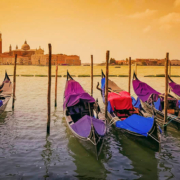Piazza San Marco is the heart of Venice – its administrative, spiritual, gastronomic, and tourist center. Every sightseeing tour of the city starts here (choose the most interesting one on this site). Naturally, this is the first stop for most tourists, which means long queues for attractions. To save time, purchase your tickets at this link.
San Marco Cathedral (Basilica di San Marco)
Built in the 11th century, the cathedral was merely a private chapel for the Doge (rulers of Venice) until the early 19th century. Only after the fall of the Republic did San Marco become a proper cathedral, and the square itself was referred to as Cathedral Square.
Externally, the church looks more grandiose than Venice’s terrain technically allows. Since the city is built on stilts, monumental structures are difficult to construct. The architects found a clever workaround – five dazzling domes made of wood, covered with lead. They appear impressive yet remain lightweight.
» READ MORE – San Marco Cathedral: Tickets, History, What to See
What’s inside?
- The priceless Pala d’Oro altar, encrusted with pearls, emeralds, sapphires, garnets, and rubies
- 8,000 square meters of mosaics
- A floor crafted entirely of marble
- An icon painted by St. Luke
- A museum housing historical relics – carpets, manuscripts, priests’ vestments, and the original Quadriga of St. Mark
You can buy a ticket to the cathedral with an audio guide at this link. Additional charges apply for access to the altar (€6), the museum (€10), and the bell tower (€12).
For something extraordinary, consider a night tour of the basilica, which includes a visit to the crypt. A perfect experience for lovers of mystery! Read more and book at this link.
Attending mass is free. Enter through the north door from Piazzetta dei Leoncini.
Doge’s Palace (Palazzo Ducale)
During the Venetian Republic, the Doge’s Palace was the political and governmental hub. After the Republic fell in 1797, its function shifted. Until the late 19th century, it housed various administrative offices, and in 1932, it was converted into a museum.
The palace also famously held Casanova, imprisoned for his scandalous lifestyle. However, he didn’t stay long – he made a daring escape. Read more about it in our article on Venice’s most infamous adventurer.
Buy a ticket for admission out of lineThe Bell Tower of San Marco (Campanile di San Marco)
Standing 98.6 meters tall, the bell tower is a restored version of the 10th-century original, which collapsed in 1902 due to structural flaws. Before that, it had withstood several earthquakes.
The tower once served as a lighthouse, a watchtower, and even a site for public executions. In 1609, Galileo Galilei presented his first telescope here to the Venetian authorities.
Today, it offers an exceptional panoramic view. Tickets cost €10 at the ticket office (€12 on the official website). An elevator is available.
» READ MORE – Venice in 1 Day: Itinerary
Three Masts (Three Flagpoles)
Those three long red poles obstructing your view of the cathedral? They’re actually flagpoles made from old ship masts. Originally, they symbolized Venice’s conquest of Crete, Cyprus, and the Peloponnese. Today, they stand for Liberty, Virtue, and Equality.
On holidays, the flags of Italy, Venice, and the European Union are flown here.
Visit San Marco Cathedral with a guide and admire the flagstones from the terracesGranite Columns (Colonne di San Marco e San Todaro)
Just beyond the square, in the Piazzetta, stand two imposing granite columns dedicated to St. Mark and St. Theodore. The first is crowned by the iconic lion of St. Mark, while the second features St. Theodore with a crocodile at his feet. The lion symbolizes Venice’s power, while the crocodile represents its dominance at sea.
In the Middle Ages, public executions were held between these columns. The locals still avoid walking between them, considering it bad luck. Will you dare?
Clock Tower (Torre dell’Orologio)
The 15th-century clock tower of St. Mark is a masterpiece of detail and symbolism.
At the top, bronze Moors – one old, one young – take turns striking the bell. The older one rings two minutes early, symbolizing the past; the younger one rings two minutes late, signifying the future.
Below them is the lion of St. Mark, Venice’s ever-present emblem. Lower still is a statue of the Virgin Mary, flanked by two clock panels — one showing Roman numerals for hours, the other Arabic numerals for minutes.
Twice a year – on Epiphany (January 6) and Ascension Day (40 days after Easter) – figures of the three wise men and an angel emerge from behind the panels.
At the center, a vibrant zodiac clock face completes the tower’s astronomical charm.
» READ MORE – 15 main sights of Venice
Procurations
The square is enclosed on three sides by the Old, New, and New Procuracies – a trio of historic buildings. Today, they house the Municipal Museum Correr, the Archaeological Museum, and the Olivetti Exhibition Hall, which showcases Carlo Scarpa’s interiors and a collection of historic typewriters.
Marciana Library
Founded in the 15th century, the Biblioteca Marciana remains Venice’s primary library and a museum. It features works by Paolo Veronese, Titian, and Tintoretto.
For access to the library, Doge’s Palace, 11 museums, and 16 churches, plus unlimited public transport, get the Venice City Pass here.
How to Get to Piazza San Marco
From Santa Lucia Train Station
- On foot: A 30-minute walk (2 km) past Santa Maria Gloriosa dei Frari and over the Rialto Bridge
- By water: Vaporetto from piers B, C, or E. Fare: €7.50. Duration: 25–30 minutes
- Passes available: If traveling frequently, consider a vaporetto pass
From Marco Polo Airport
- Vaporetto: Follow signs for «Trasporti via d’acqua.» Duration: 60 minutes. Fare: €15
- Water taxi: A direct transfer to your hotel – perfect for heavy luggage or family travel. Book here
Where to Eat Near Piazza San Marco
Best View Restaurant: Terrazza Danieli (Hotel Danieli rooftop). Exquisite dining with Grand Canal views. €150 for a seven-course tasting menu (excluding drinks).
Historic Café: Caffè Florian — Europe’s oldest coffeehouse (1640). Frequented by Proust, Dickens, Monet, Warhol, and Chaplin. Expect to pay extra for live music.
Where to Stay Near Piazza San Marco
- Luxury: San Marco Luxury 4* (near the cathedral)
- Mid-range: Rosa Salva Hotel
- Budget: San Samuele 1* (10 min walk)
How Not to Get Fined in Venice
Venice enforces strict regulations to protect its historic center. Common fines:
- Swimming in canals – €500
- Feeding pigeons – €50–200
- Walking shirtless – €200
- Littering – €100–200
- Cycling in the square – €100
- Smoking in Piazza San Marco – €200
For more Venice travel tips, check out our gondola guide and top 20 things to do.
Enjoy your trip!




 voyage10.com
voyage10.com 
 Peggychoucair / Pixabay
Peggychoucair / Pixabay  Vera Kratochvil / publicdomainpictures.net / CC0
Vera Kratochvil / publicdomainpictures.net / CC0  Markéta Jaklová / Pixabay
Markéta Jaklová / Pixabay 
 Anne and Saturnino Miranda / Pixabay
Anne and Saturnino Miranda / Pixabay Peggychoucair / Pixabay
Peggychoucair / Pixabay
Leave a Reply
Want to join the discussion?Feel free to contribute!